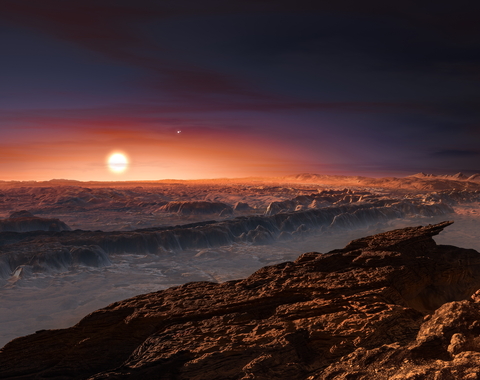Today’s search for Earth-like planets is driven by our desire to understand our place in the universe and to answer the age-old question: Are we alone?
To tackle that question, we must first answer another: What exactly is an 'Earth-like' planet?
We asked five scientists from different fields of study at the Carnegie Science Earth and Planets Laboratory to share their answers.
It turns out that defining what makes a planet "Earth-like" isn't as straightforward as you might imagine, thanks to the highly interdisciplinary nature of this burgeoning area of research. From astronomers to geochemists, each field brings a unique lens to the study of exoplanets.
At Carnegie Science, these research areas converge, fostering a collaborative environment that makes it the ideal place to tackle these complex, cross-disciplinary questions.
More Resources
Anat Shahar: If you told me that this was a planet and asked me if it was Earth-like, I would tell you yes, it's Earth-like because it has two features in particular: one is lots of liquid water, which I would assume would be this blue stuff, and the other is this stuff so I would tell you that because it has plate tectonics because it has the ability to recycle nutrients that life needs, that it's also an Earth-like planet.
So an Earth-like planet can be defined in different ways and it really depends on who you ask. For example, if you ask me as an isotope geochemist what an Earth-like planet is, I would tell you that an Earth-like planet is a planet that has the same chemical and isotopic abundances as the Earth, which is very different than asking what's an Earth-like planet in terms of a planet that has life.
Johanna Teske: So when I think of what does an Earth-like planet mean to me, I'm thinking about its mass, its radius, what kind of star it orbits, and from my perspective one of the most important ones is the surface temperature, and that we can have liquid water that has seemed to be really important for having life on our planet.
Michael Wong: For me, an Earth-like planet is not a binary; it's a spectrum. You're not either an Earth-like planet or not an Earth-like planet; it's really difficult for me in this framework to try to pin down one single characteristic that is most important to making an Earth-like planet an Earth-like planet. I would probably say that it's the ability to generate novelty, new phenomena and processes that come into existence that can then have a chance at coupling with the rest of the phenomena at play on that world.
Dana Anderson: So as an astrochemist, I would consider the chemical composition of a planet to be important, and to whether or not it's Earth-like to how much carbon, nitrogen, oxygen is in the planet relative to heavier elements like silicon, magnesium, and iron, and this might be important for the structure and evolution of the planet but also for its ability to potentially host Earth-like life.
Peter Driscoll: For me, an Earth-like planet is something that has the features of the Earth, so not only its mass, its density, its composition but also some aspects of its evolution, for example, Earth has plate tectonics, it has liquid water on its surface, and it has had a magnetic field for as long as we can tell, and it also has life of course, and I don't think these things are coincidences.
Michael Wong: The reason why we care about Earth-like planets, to begin with, is because we want to know our place in the universe, we want to know if we're alone, we want to know if there are other planetary bodies that could harbor life.
Dana Anderson: So, finding Earth-like planets might say something about the processes that it takes to form one, whether it's very common or more rare. Do you need a specific type of star in a very specific environment with very specific chemical materials to make an Earth-like planet, or is it something that we find commonly across the Galaxy?
Johanna Teske: Part of what I'm interested in in my research actually is pushing those boundaries and figuring out okay if we have a planet that is a little bit hotter or a little bit bigger or more massive than the earth, could that still have conditions that we would consider Earth-like?
Anat Shahar: I think that Carnegie Science is a great place to ask this question because we have such a diverse and large range of scientists who are all coming at this question from so many different angles that together, I think we can really start to answer this very complicated question.
In this video, various scientists discuss what constitutes an "Earth-like" planet, each providing insights based on their unique fields of study.
The discussion highlights several criteria that might make a planet similar to Earth, including the presence of liquid water, plate tectonics, and specific chemical and isotopic compositions. Differences in defining earthlike conditions—whether it's from the perspective of an isotope astronomer, geochemist, astrochemist, geophysicist, or astrobiologist—are explored.
The scientists emphasize that the concept of an Earth-like planet involves multiple aspects, such as the planet's mass, surface temperature, and ability to support life. They also discuss the importance of such research in understanding our place in the universe, the potential for finding life on other planets, and what makes Carnegie Science a good place to do this kind of interdisciplinary research.
- Wong, M. L., Duckett, M., Hernandez, E. S., Rajaei, V., & Smith, K. J. (2024). The process we call Earth: Relationships between dynamic feedbacks and the search for Gaiasignatures in a new paradigm of Earthlikeness. Perspectives of Earth and Space Scientists, 5, e2023CN000223. https://doi.org/10.1029/2023CN000223
- Anat Shahar et al., What makes a planet habitable?.Science 364,434-435(2019).DOI:10.1126/science.aaw4326
- Young, E.D., Shahar, A. & Schlichting, H.E. Earth shaped by primordial H2 atmospheres. Nature 616, 306–311 (2023). https://doi.org/10.1038/s41586-023-05823-0

On the Horizon
We can't physically journey to these distant worlds to gauge their Earth-likeness. Instead, scientists rely on remote observation techniques. By analyzing exoplanet atmospheres, we can uncover vital clues about their inner workings. For example, the presence of certain gases, like oxygen and methane, hint at life-sustaining processes, while atmospheric variations offer insights into a planet's dynamics.
However, with current telescope technology, Earth-sized planets are almost impossible to spot. In the future, the Giant Magellan Telescope will join the search, providing even sharper views from the Earth's surface, and greatly enhancing our ability to find Earth-like planets.




